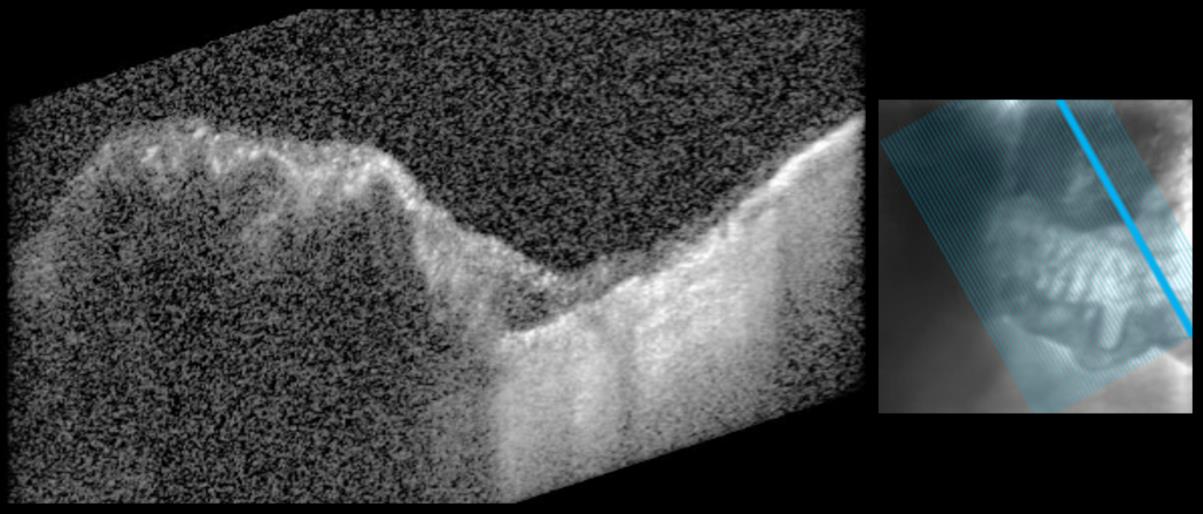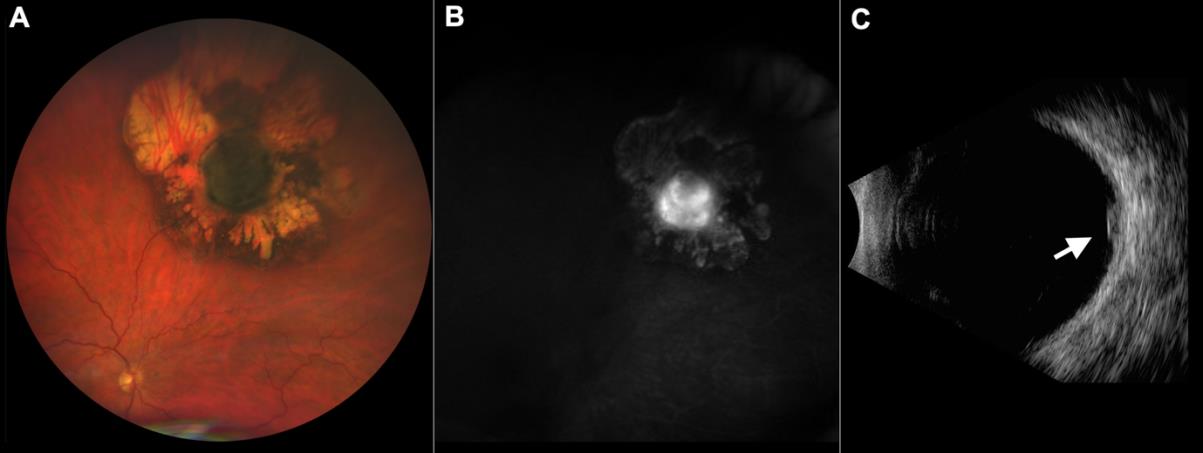Authors
Victor C. F. Bellanda, M.D.1; Arpita S. Maniar, M.D.2; Miguel A. Materin, M.D.2*
1Ribeirão Preto Medical School, University of São Paulo – Ribeirão Preto, SP, Brazil 2Duke Eye Center, Duke University – Durham, NC, USA
*Corresponding author:
Miguel A. Materin, M.D.
Duke Eye Center - Duke University 2351 Erwin Rd, Durham, NC 27705-4699
Tel: (919) 681-3937
E-mail: miguel.materin@duke.edu
DOI: https://doi.org/10.62856/djcro.v1i1.8
Introduction
Congenital Hypertrophy of the Retinal Pigment Epithelium (CHRPE) presents as a flat, black-brown lesion with scalloped or jagged borders. Typically benign, it may slowly enlarge in diameter. Rarely, a malignant neoplasm of the retinal pigment epithelium (RPE) may arise within a CHRPE. The tumor typically appears as a deeply pigmented nodule with surrounding exudation, retinal hemorrhage, and edema.1 Herein, we present multimodal imaging of one such lesion arising from a CHRPE.
Case Description
An otherwise healthy 59-year-old male patient was referred for evaluation of a possible choroidal melanoma in the right eye, identified on a routine examination. Upon fundus examination, a pigmented nodular lesion measuring 4x4x2 mm was detected along the superonasal equator. The nodule was observed to be originating from an 11x11 mm flat, well-defined, partly pigmented retinal lesion, characteristic of CHRPE. There was vitreous hemorrhage overlying the lesion and there was no associated exudation.
Optical coherence tomography (OCT) confirmed the existence of an irregularly elevated retinal lesion that originated from a hyper-reflective retinal pigment epithelium (RPE), as shown in Figure 1. Serial imaging over the ensuing months demonstrated the lesion's stability in size and the resolution of the associated vitreous hemorrhage. This improvement facilitated the capture of a higher-resolution fundus photograph (Figure 2-A) and fluorescein angiography (Figure 2-B). The angiography further revealed the lesion's hyperfluorescence, surrounding staining, blocked fluorescence regions, and the presence of feeding retinal vessels. B-scan ultrasonography confirmed a hyperechoic lesion arising from the retina that was 2 mm in thickness (Figure 2-C). The lesion was subsequently diagnosed as an RPE neoplasm, likely an adenoma originating from CHRPE considering its stability over a sixteen-month follow-up period.

Figure 1. OCT study through the lesion reveals an irregularly elevated retinal lesion with a hyper-reflective surface, arising from a hyper-reflective retinal pigment epithelium layer.

Figure 2. A) Fundus photograph shows a flat, partly pigmented lesion with scalloped margins, depigmented lacunae revealing underneath choroidal vascularity, compatible with congenital hypertrophy of the retinal pigment epithelium (CHRPE), and a pigmented nodule emerging from its surface. B) Early-phase fluorescein angiography shows lesion hyperfluorescence with surrounding staining and areas of blocked fluorescence. C) B-scan ultrasonography reveals a 2.0mm-thick hyperechoic nodule (white arrow).
Discussion
The occurrence of a neoplasm arising from CHRPE is exceedingly rare, with only six cases documented in scientific literature so far,1–4 three of which were posteriorly excised due to non-reassuring growth and were diagnosed as adenocarcinoma on histopathological examination.2-4
In contrast with the six cases previously documented, our patient was unique in initially presenting with an overlying vitreous hemorrhage. Similar to past reports of nodular lesions arising from CHRPE, the presentation in our case was also unilateral, unifocal, and located at the eye's equator. The CHRPE lesions from which these tumors emerged were significantly larger than the average size usually observed for such lesions, and all exhibited the presence of lacunae.1-5 Half of the prior cases were managed surgically due to non-reassuring growth patterns, while our patient’s lesion remained stable over a sixteen-month follow-up period. All excised tumors were classified as malignant (adenocarcinoma) on histopathology. However, the stability in our case could suggest a less aggressive nature of the neoplasm, representing an RPE adenoma, or might indicate an early stage in its natural history, warranting ongoing close observation.
The terminology for these neoplasms remains a subject of debate. Shields et al proposed that adenomas and adenocarcinomas arising from the RPE should be called epitheliomas and malignant epitheliomas, respectively, since they consist of a proliferation of RPE cells only and have no glandular features on histopathology.5 It is still unclear whether all adenomas will eventually progress to adenocarcinomas. The stability observed in our case reassures the possibility of conservative management with vigilant monitoring for certain patients, depending on lesion characteristics, presence or absence of hemorrhage and exudation, as well as evolution over time. Future research should aim to establish guidelines for when intervention is warranted versus when conservative management is acceptable.
Conclusion
In summary, this case report adds a unique contribution to the limited body of literature on neoplasms arising from CHRPE. Notably, this is the first report to include an OCT study through the lesion, providing insights into its structural characteristics and contributing to our understanding of these rare tumors. Future work should focus on the long-term outcomes and management strategies for these rare tumors.
References
1. Shields JA, Shields CL, Singh AD. Acquired Tumors Arising From Congenital Hypertrophy of the Retinal Pigment Epithelium. Arch Ophthalmol. 2000;118(5):637-641.
2. Shields JA, Shields CL, Eagle RC Jr, Singh AD. Adenocarcinoma Arising From Congenital Hypertrophy of Retinal Pigment Epithelium. Arch Ophthalmol. 2001;119(4):597-602.
3. Trichopoulos N, Augsburger JJ, Schneider S. Adenocarcinoma arising from congenital hypertrophy of the retinal pigment epithelium. Graefes Arch Clin Exp Ophthalmol. 2006;244(1):125-128.
4. Shields JA, Eagle RC, Shields CL, Brown GC, Lally SE. Malignant Transformation of Congenital Hypertrophy of the Retinal Pigment Epithelium. Ophthalmology. 2009;116(11):2213-2216.
5. Shields JA, Shields CL. Tumors and related lesions of the pigment epithelium. In: Shields JA, Shields CL, eds. Intraocular Tumors. An Atlas and Textbook. 2nd ed. Lippincott, Williams & Wilkins; 2008:432– 83.
Informed Patient Consent
The patient consented to publication of the case in writing. This report does not contain any personal information that could lead to their identification.
Statement of Ethics
This case report adheres to patient confidentiality and ethical principles in accordance with the guidelines of the Declaration of Helsinki and relevant local regulations. Written consent was obtained from the patient for the publication of this case report.
Conflict of Interest Statement
The authors declare no conflicts of interest related to this topic.
Acknowledgments
Funding: This work received no funding or grant support.
Authorship: We attest that all authors contributed significantly to the creation of this manuscript, each having fulfilled the criteria as established by the ICMJE.
Acknowledgments: We acknowledge the reported patient for agreeing with the disclosure of his case for the benefit of scientific development and medical education.